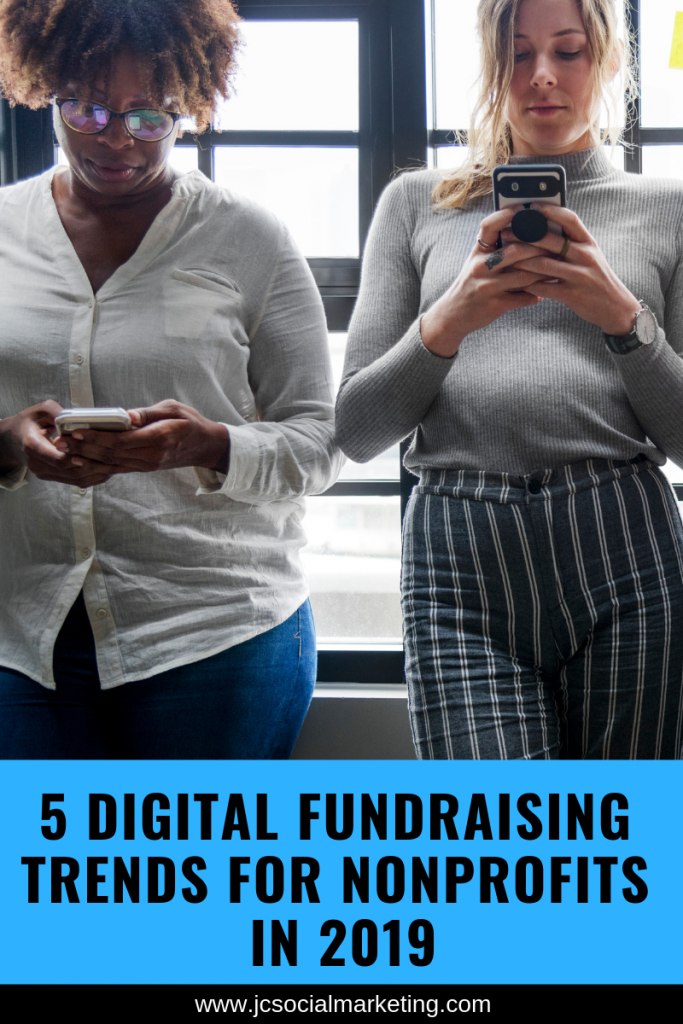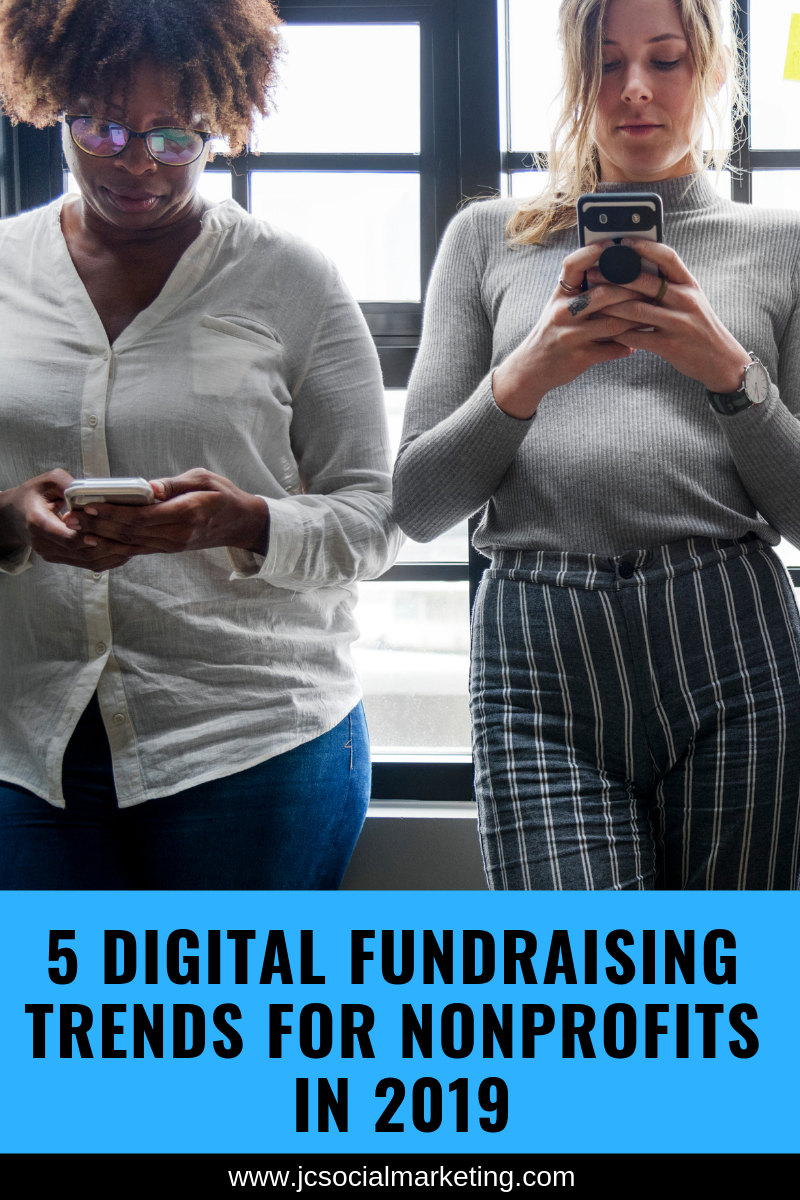 Planning for 2019 is in full swing, so it’s time to assess current and upcoming trends in digital fundraising and how your nonprofit can leverage them for maximum impact.
Planning for 2019 is in full swing, so it’s time to assess current and upcoming trends in digital fundraising and how your nonprofit can leverage them for maximum impact.
Before we begin, please note: This is not a TO DO list!
These are trends, which are fun to talk about, but can get overwhelming for the digital fundraiser that already has too many items on her plate.
Do not read this post unless you already have a digital strategy for 2019, and you are looking for new, innovative ways to reach your target audience and accomplish your specific goals.
For more information on how to create your nonprofit digital strategy, check out last week’s post on this topic.
Got your plan? Great! Let’s get started.
In my latest Facebook Live video and this post, I dive into what I expect to be the top 5 digital fundraising trends for 2019.
Watch below:
#1 People are craving more human content, specifically via video.
So, you may have been seeing a teensy little bit of backlash against social media lately? Maybe?
The way to combat this backlash is to be even more accessible and human that you are comfortable with.
Use video to lift the veil on your work.
People want access, authenticity, and transparency.
In this same vein, people prefer to interact with amateur content than celebrities.
There are 3 ways to jump on the trend of human-centered video:
a) Facebook Live
University presidents talk to alumni through livestream during campus giving days.
The Humane Society goes live from the field.
The New York Public Library goes live from events.
For many more examples and tips, check out this post: 8 Ways to Use Live-Streaming Video to Share Stories as They Happen
b) Persicope via Twitter
No Kid Hungry used Periscope to monitor their live Wall of Thanks and give shout outs to donors on Giving Tuesday:
It’s #GivingTuesday and we’re live from our Wall of Thanks where we’re giving shout outs 🎉 https://t.co/1Ncx4BAPp4 https://t.co/WfOJnYuglG
— No Kid Hungry (@nokidhungry) November 27, 2018
c) Instagram Stories
Expect a much longer blog post about how to use Instagram Stories, but for our purposes today, consider the rise of the inspirational Alexandria Ocasio-Cortez.
Ocasio-Cortez, the 29-year-old representative from New York’s 14th congressional district, who will become the youngest serving congresswoman ever come January.
She has used Instagram Stories and Instagram Live to build an engaged community of raving fans, with the purpose of taking politics out of the ivory tower of DC and putting the power back in the hands of the voters.
Digital fundraising is not all about the ask – it’s about cultivating an engaged group of supporters who love you and who want to share your work with others.
Think of digital fundraising and community building like dominoes.
Build up your dominoes by showing people your work, letting them know and trust you, and then asking them to participate and get involved (knocking down the dominoes – and building them again).
#2 Instagram is poised for even more growth.
Of the social networks, only Facebook and YouTube have more people logging in. With 500 million of them using Instagram—every day.
59% of U.S. users are under 30.
72% of users have bought a product they saw on Instagram.
Nonprofits need a more strategic way to approach Instagram, rather than simply posting something every few weeks.
Take a look at the IRS’ new Instagram Strategy:
They have a defined audience. The IRS wants to reach younger taxpayers, millennials especially. In an interview, their social media teach said that “It’s a matter of meeting the taxpayers where they are.”
They have a defined purpose. Their goal is to spread useful information to help people get ready for the upcoming tax season.
They have reasonable expectations. They understand that the subject of taxes is never going to have as many followers as a movie star or a pop star.
Their posts are meant for Instagram. All their posts are eye-catching, colorful, and have an element of surprise. For example, their first post is bright pink and features flamingos!
#3 P2P Social Media Fundraising is growing, specifically through Facebook Fundraising and donated birthdays.
YouTube Giving tools are also ones to watch, but they don’t have the P2P aspect of Facebook fundraisers (at least, not yet).
My recommendation is to get registered with Facebook Fundraising tools by going to donations.fb.com and then creating a strategy to get people to set them up and raise money for you in 2019.
On Giving Tuesday this year over $125 million was raised via Facebook Fundraising.
It’s not a silver bullet, and it’s certainly not EASY, but the principles of success are simple.
I talk about about Facebook Fundraising in much more detail up in previous blog posts and Facebook Live videos.
#4 Livestreaming via gaming platforms like Twitch are forces to reckon with.
I have to admit that I have never watched anything on Twitch, but I’ve been reading a lot about it
Launched in 2011 by Justin Kan and Emmett Shear, the online video platform is comparable to sites like YouTube or Vimeo, except that it focuses exclusively on live video.
15 million users tune in to watch an average of 1.5 hours of Twitch live streams each day.
During Suicide Prevention Awareness Month, the Seize the Awkward campaign ran a three-day Twitch event to raise funds for their mental health work.
More info: Going Live: How Nonprofits Are Reaching Younger Donors by Streaming Games Online
#5 Artificial Intelligence and Chatbots are here, and nonprofits need to get on board.
This is a big one, and I can’t claim to be an expert.
I do have an entire Pinterest board with collected stories, examples, and resources on this topic: AI and Chatbots for Nonprofits
Beth Kanter past year wrote an op-ed for the Chronicle of Philanthropy on the age of automation and it implications for fundraisers.
Kanter also compiled a great list of chatbots that nonprofits can study, research, and use for ideas and inspiration.
Susan G. Komen Florida implemented a chatbot, using ManyChat, as a way to provide ease of access to resources and information.
For the 2019 Race for the Cure, Komen Florida’s chatbot will answer important questions to race participants.
Nonprofits, even small ones, need to begin to understand at lesat what a chatbot is and how it works.
I am going to be launching several new exciting projects in 2019, so make sure you sign up for my email list to be the first to know: https://jcsocialmarketing.com/workbook
